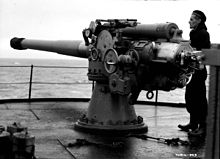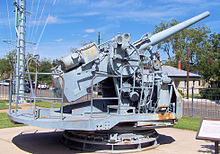- Defensively Equipped Merchant Ships
-
Defensively Equipped Merchant Ship (DEMS) was an Admiralty Trade Division program established in June, 1939, to arm 5,500 British merchant ships with an adequate defence against enemy submarines and aircraft. The acronym DEMS was used to describe the ships carrying the guns, the guns aboard the ships, the military personnel manning the guns, and the shore establishment supporting the system.[1]
Contents
Background
In the eighteenth and nineteenth centuries, European countries such as Spain, France, Canada Holland and Britain armed their merchant ships to prevent capture by pirates, enemy commerce raiders and privateers when they conducted overseas trade. The most heavily armed were ships carrying valuable cargo back from the Far East. For example, the East Indiamen class of ships were constructed from the ground up with defence in mind, with their heavy armament making them equivalent to naval ships of the line. Once the threat passed after the end of the Napoleonic Wars in 1815, armed merchant ships like East Indiamen were replaced with faster and lighter unarmed ships such as clippers.
World War I
During the First World War, Britain armed its merchant ships to help defend them against U-boats. A single stern gun, equivalent to what a submarine might carry, was mounted; and civilian captains were encouraged to flee and shoot back from their more stable gun platform. 766 civilian ships had been armed by December, 1915.[2] Arming of merchant ships gave Germany an excuse for moving toward unrestricted submarine warfare.[3]
The first merchant ship lost to U-boats was an 866-ton British steamer outbound from Grangemouth to Stavanger with a cargo of coal, iron plate, and oil. SS Glitra was stopped by U-17 on 20 October 1914; and a boarding party gave Glitra's crew time to disembark into lifeboats before sinking the ship by opening valves to flood holds with seawater. The procedure followed customs originated by surface ships. International maritime law required the naval vessel to make adequate provisions for the safety of the merchant crew and passengers before sinking their ship.[4]
Imperial Germany focused use of U-boats against merchant shipping in response to British blockade of German merchant shipping by declaring the entire North Sea a war zone on 2 November 1914. On 5 February 1915 Germany published notice declaring a war zone in all waters around Great Britain and Ireland. Within that zone, Germany conducted unrestricted submarine warfare against merchant ships from 18 February 1915 without warning and without regard to safety of their crew.[5]
U-boats still conformed to earlier conventions of stopping ships when possible, but the typical submarine mounted only a single gun. The two procedures for sinking merchant ships were compared in 1915. Merchant ships escaped 42% of torpedo attacks made without warning, in comparison to 54% escaping from conventional surface attempts to stop the ship.[6] Guns aided escape and approximately one submarine per month was sunk (most by Q-ships) while attempting a surfaced stop.[6]
The number of civilian merchant ships armed with anti-submarine guns rose to 1,749 by September 1916 and 2,899 by February 1917.[7] The United States responded to unrestricted submarine warfare by severing diplomatic relations with Germany on 3 February 1917. A filibuster in the United States Senate temporarily delayed President Woodrow Wilson's proposal on 26 February 1917 to arm United States merchant ships, but arming started in March under an executive order.[8]
World War II


BL 4 inch Mk VII low-angle gun on a DEMS in 1943, an obsolete WWI gun typical of WWII DEMS armament Old naval guns had been stored since 1918 in major seaports for possible use during future hostilities. During the Second World War, the objective was to equip each ship with a low-angle gun mounted aft as defence against surfaced submarines and a high-angle gun and rifle-calibre machine guns for defence against air attack.[9] 3,400 ships had been armed by the end of 1940;[3] and all ships were armed by 1943.[10]
The low-angle guns were typically in the 3-inch to 6-inch range (75–150 mm) depending on the size of the ship. Rifle-caliber machine guns were augmented or replaced by 20 mm Oerlikon as they became available. The High-Angle QF 12pdr Mk V mount was the most common anti-aircraft gun, and later ships sometimes received 40 mm Bofors guns.[9]
Untrained gunners posed significant risk to friendly aircraft in the absence of efficient communications.[3] DEMS guns were manned by 24,000 Royal Navy personnel and 14,000 men of the Royal Artillery Maritime Regiment. 150,000 merchant sailors were trained to assist by passing ammunition, loading, and replacing casualties among the military gun crew.[11] Initially, Royal Artillery personnel provided anti-aircraft protection by bringing their own machine-guns aboard ships operating close to the British Isles.[3] DEMS gunners were often retired military personnel and young "Hostilities Only" ratings commanded by a petty officer or Royal Marine sergeant. Large ships sometimes embarked a junior naval officer to command the DEMS gunners.[12]
Canada placed guns on 713 ships.[13]
D-day landings and the Royal Observer Corps
In 1944, during preparations for the invasion of France called Operation Overlord there was deep concern over the danger to Allied aircraft from the large number of DEMS involved in the landings. A request for volunteer aircraft recognition experts from the Royal Observer Corps produced 1,094 highly qualified candidates, from which 796 were selected to perform valuable aircraft recognition duties as seaborne volunteers.[14]
These Seaborne Observers were organised by Group Commandant C.G.Cooke and trained at the Royal Bath Hotel Bournemouth before the volunteers temporarily joined the Royal Navy with the rank of Petty Officer (Aircraft Identifier). The volunteers continued to wear their ROC uniforms, but wore SEABORNE shoulder flashes and a Royal Navy brassard with the letters RN. During the D-day landings two Seaborne observers were allocated to each of the Defensively Equipped Merchant Ships, both British and American vessels. The ROC volunteers were given direct control of each ship's anti aircraft batteries, immediately reducing the previously high level of friendly fire, or collateral damage incidents as they are now known. Their success is measured by a signal from Wing Commander P.B. Lucas, Air Staff Officer who reported:
- "The general impression amongst the Spitfire wings, covering our land and naval forces over and off the beach-head, appears to be that in the majority of cases the fire has come from warships and not from the merchant ships. Indeed I personally have yet to hear a single pilot report that a merchant vessel had opened fire on him"
Twenty two Seaborne observers survived their ships being sunk, two lost their lives and several more were injured during the landings. The Seaborne operation was an unqualified success and in recognition, His Majesty King George Vl approved the wearing of the SEABORNE flash as a permanent feature of the uniform. In addition, ten Seaborne members were mentioned in despatches. After the invasion and just before his death Air Chief Marshal Trafford Leigh-Mallory wrote the following to be circulated to all ROC personnel:
- "I have read reports from both pilots and naval officers regarding the Seaborne volunteers on board merchant vessels during recent operations. All reports agree that the Seaborne volunteers have more than fulfilled their duties and have undoubtedly saved many of our aircraft from being engaged by our ships guns. I should be grateful if you would please convey to all ranks of the Royal Observer Corps, and in particular to the Seaborne observers themselves, how grateful I, and all pilots in the Allied Expeditionary Air Force, are for their assistance, which has contributed in no small measure to the safety of our own aircraft, and also to the efficient protection of the ships at sea.
- The work of the Royal Observer Corps is quite often unjustly overlooked, and receives little recognition, and I therefore wish that the service they rendered on this occasion be as widely advertised as possible, and all units of the Air Defence of Great Britain are therefore to be informed of the success of this latest venture of the Royal Observer Corps."
As of 2010 there is a Seaborne Observers’ Association for the dwindling number of survivors. Ex-Air Vice-Marshal George Black, a former Commandant ROC, is the honorary president.
United States
The Merchant Marine Act of 1936 identified mariners aboard United States flagged merchant ships as military personnel in time of war. Neutrality Acts prevented arming of United States flagged merchant ships until 17 November 1941, although American-owned ships under Panamanian registry had been armed earlier.[15] Guns were manned by United States Navy Armed Guard. United States began equipping ships of other nations with guns and United States Navy Armed Guard on 24 January 1942.[16] United States policy was stated by the Vice Chief of Naval Operations on 19 August 1942: "Ships sailing independently should be armed. Ships sailing in regularly made-up convoys, other than ships bound to North Russia or tankers en route to the United Kingdom, may sail unarmed if the urgency of delivery of their cargo warrants it."[11]
The United States followed the British practice of a single large gun aft. Early United States installations included low-angle 4"/50 calibre guns (Mark 9) removed from old Wickes and Clemson class destroyers.[17] The first installations of dual-purpose 5"/38 calibre guns began in September, 1942, on new ships over 10,000 tons.[11] Victory ships carried a 3-inch gun on the bow, 20 mm machine gun tubs port and starboard between the first and second holds; a second pair of 20 mm guns on the bridge wings, a third pair on the after edge of the superstructure, and a fourth pair between the after (Number 5) hatch and the 5"/38 calibre gun on the stern.[18]
See also
Notes
- ^ Hague 2000 p.VIII
- ^ Tarrant 1989 p.17
- ^ a b c d van der Vat 1988 p.124
- ^ Tarrant 1989 p.12
- ^ Tarrant 1989 pp.13-14
- ^ a b Tarrant 1989 p.22
- ^ Tarrant 1989 p.37
- ^ Potter & Nimitz 1960 p.465
- ^ a b Hague 2000 p.101
- ^ Middlebrook 1976 p.30
- ^ a b c Morison 1975 p.301
- ^ Hague 2000 p.102
- ^ van der Vat 1988 pp.138-9
- ^ ROC Seaborne Ops
- ^ Morison 1975 pp.296-7
- ^ Morison 1975 p.297
- ^ Campbell 1985 pp.143
- ^ Babcock & Wilcox 1944 pp.6-7
References
- Babcock and Wilcox (April 1944). Victory Ships. Marine Engineering and Shipping Review.
- Campbell, John (1985). Naval Weapons of World War Two. Naval Institute Press. ISBN 0-87021-459-4.
- Hague, Arnold (2000). The Allied Convoy System 1939-1945. Naval Institute Press. ISBN 1-55750-019-3.
- Hughes, Terry and Costello, John (1977). The Battle of the Atlantic. The Dial Press. ISBN 0-8037-6454-2.
- Middlebrook, Martin (1976). Convoy. William Morrow and Company. ISBN 0713909277.
- Morison, Samuel Eliot (1975). History of United States Naval Operations in World War II, Volume I The Battle of the Atlantic 1939-1943. Little, Brown and Company.
- Potter, E.B. and Nimitz, Chester W. (1960). Sea Power. Prentice-Hall.
- Rohwer, J. and Hummelchen, G. (1992). Chronology of the War at Sea 1939-1945. Naval Institute Press. ISBN 1-55750-105-X.
- Tarrant, V.E. (1989). The U-Boat Offensive 1914-1945. Sterling Publishing. ISBN 1-85409-520-X.
- van der Vat, Dan (1988). The Atlantic Campaign. Harper & Row. ISBN 0-06-015967-7.
- Slader, John (2009). Fourth Service: Merchantmen at War, 1939-45. Brick Tower Books. ISBN 978-1899694457.
Further reading
- Marcus, Alex (1986). "DEMS? What's DEMS?": The story of the men of the Royal Australian Navy who manned defensively equipped merchant ships during World War II. Bowen Hills, Qld.: Boolarong Publications. pp. 209 pages. ISBN 0864390122.
Categories:- Naval warfare
- Military strategy
- Ship types
Wikimedia Foundation. 2010.


